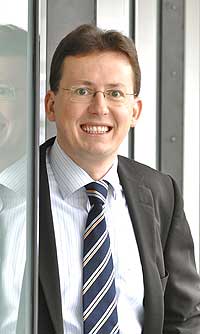Malware Insights: Android Infection Rates and Techniques for Identifying Unknown Malware
In the second research result of the month, we report on the recent results in understanding mobile malware. The research was presented and published in the prestigious World Wide Web conference in April 2014.
Research result of the month: Malware Insights - Android Infection Rates and Techniques for Identifying Unknown Malware
In the second research result of the month we report on the recent results in understanding mobile malware. Smartphones are now ubiquitous, personal and store a lot of personal information about their users. Calls and messaging cost money to users, and smartphones are also increasingly used for direct financial transactions. Therefore, one of the great fears about smartphone use is the possibility of large-scale viral infection.
The Malware Insights team at the Intel Collaborative Research Institute for Secure Computing (ICRI-SC) (http://www.icri-sc.org) at the Department have shown that infection rates in Android devices are around 0.25 per cent, significantly higher than the previous independent estimate. They also developed a technique to identify devices infected with previously unknown malware.
The project team, consisting of Hien Truong, Eemil Lagerspetz, Sourav Bhattacharya, and Petteri Nurmi working under the guidance of Professor N. Asokan and Professor Sasu Tarkoma, and collaborating with Adam J. Oliner from the UC Berkeley AMP Lab, published an article on the recent results at this year’s World Wide Web conference (http://www2014.kr/).
Android Infection Rates
There is a steady stream of news stories and announcements about how many more new strains of Android malware appear every passing year. Data showing infection rates in the real world has been hard to come by. There is a lot of data about the number of different malware samples discovered but not so much about the extent they are actually found in the wild. If smartphones were infected to the same extent as personal computers used to be, the resulting damage would be much more severe.
The few estimates that are out there vary greatly: ranging from more than 4 per cent of Android devices, according to an estimate by an anti-virus company, to less than 0.0009 per cent of smartphones in the US, according to a different estimate by group of academic researchers from the US.
What is the reason for this disparity?
The team has been investigating the true extent of malware infection in Android devices. They discovered that infection rates in Android devices are at around 0.25 per cent, significantly higher than the previous independent estimate. The project collected anonymized data from over 50 000 devices during a seven-month period.
An arXiv research report based on the work being done at the "Malware Insights" project at the department of Computer Science has been featured (http://www.technologyreview.com/view/522771/first-direct-measurement-of-infection-rates-for-smartphone-viruses/) in MIT Technology Review's "Emerging Technology From the arXiv" section.
Identifying Unknown Malware
"This is only the beginning. We are now trying to improve the accuracy of our results and are investigating whether we can identify vulnerable devices even before they are infected. I am very excited about the prospects of using data insights to improve security techniques,” professor Asokan explains.
The researchers speculated that smartphones infected with malicious apps may have other, benign, apps in common, possibly because the users purchase them all from the same app market. Based on this conjecture, the researchers investigated if it is possible to develop a technique to identify devices infected with previously unknown malware. In their dataset, this approach is up to five times more likely to identify infected devices than by choosing devices at random.
“The detection of zero-day malware applications is crucial for enabling the mitigation of their adverse effects. Our work aims to detect vulnerable devices and screen them so that new malware applications can be stopped as fast as possible,” professor Tarkoma adds.
Picture: From the left, Sourav Bhattacharya, Eemil Lagerspetz, Hien Truong and Adam J. Oliner attending the conference.
Link to the article:
The company you keep: mobile malware infection rates and inexpensive risk indicators. WWW 2014. http://doi.acm.org/10.1145/2566486.2568046.

 Mika Urtela and Hannu Pajula, graduates of the Department of Computer Science, are realising their piña colada-flavoured dreams in their game-producing company, Soul Aim Studios. This is the beginning of their story. The piña colada part of it has not come true yet, but they're working at it.
Mika Urtela and Hannu Pajula, graduates of the Department of Computer Science, are realising their piña colada-flavoured dreams in their game-producing company, Soul Aim Studios. This is the beginning of their story. The piña colada part of it has not come true yet, but they're working at it. FiDiPro - the Finland Distinguished Professor Programme - enables distinguished international researchers to work and team up with the 'best of the best' in Finnish academic research. Financed by the Academy of Finland and Tekes, FiDiPro makes it possible to recruit highly merited scientists who are able to commit to long-term cooperation with a Finnish university or research institute.
FiDiPro - the Finland Distinguished Professor Programme - enables distinguished international researchers to work and team up with the 'best of the best' in Finnish academic research. Financed by the Academy of Finland and Tekes, FiDiPro makes it possible to recruit highly merited scientists who are able to commit to long-term cooperation with a Finnish university or research institute. The Faculty of Science invited Linus Torvalds to be its honorary alumnus in Kumpula. During its alumni event, the faculty also named one of its lecture halls after Linus Torvalds. On the event held on Thursday 17 March, young researchers were the main speakers, and the 350 guests on the science campus gave them their full attention.
The Faculty of Science invited Linus Torvalds to be its honorary alumnus in Kumpula. During its alumni event, the faculty also named one of its lecture halls after Linus Torvalds. On the event held on Thursday 17 March, young researchers were the main speakers, and the 350 guests on the science campus gave them their full attention.